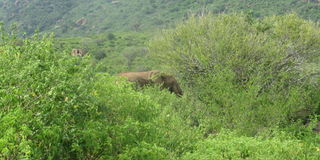A close encounter with a tusker at Tsavo

Tsavo West National Park visit. PHOTO|RUPI MANGAT
What you need to know:
What you need to know:
- According to Kenya Wildlife Service, Kenya’s elephant population increased from 16,000 in 1989 to 34,800 by the end of 2019
- The threat today is habitat loss and migratory paths being blocked by infrastructure and farms like the 180-acre avocado farm between Amboseli and Tsavo West now thankfully halted until the next hearing
A few weeks ago, driving in through the Tsavo Gate into Tsavo West, the fragrance of a flowering bush filled the air for miles. Everything was lush with after the rains, with the mighty baobabs heaving with seed pods on the rich-red earth. The Tsavo River was in spate flowing close to the huge rocks where the man-eaters of Tsavo, the two maneless male lions killed many a railroad worker on the Lunatic Line in 1898.
Save for one car, we were alone for the entire day. The road up Ngulia escarpment was enchanting with the most stunning views of the valley lined by the jagged peaks of Ngulia. Our mission was to visit the park’s Rhino sanctuary which opens at 4pm.
The long necks of Maasai giraffes popped out of the dense green scrub, a pair of Coke’s hartebeest lounged on the side of the road, tiny dikdiks and squirrels scampered across the road and the fragrance of the flowers lingered.
Deep into the park, red dots appeared. It was a herd of red elephants quietly browsing and as we drove closer, the elephants got bigger. Amongst them were the calves, a veritable nursery.
The view was surreal with the ‘red’ elephants of Tsavo coated in its earthy soils between the sweep of the valley and the jagged peaks of the Ngulia hills. We sat quietly relishing quiet time with the world’s largest land mammal.

Pale chanting goshawk at Tsavo West National Park. PHOTO|RUPI MANGAT
Some ten minutes passed. Suddenly, a huge red elephant filled my eyeballs. Turning around the elephant was behind the car, only a few feet away. We sped off in haste with the red lady behind us – not trumpeting, not flapping her ears or running to charge at us.
With pounding hearts, we stopped at the crossroad. The thought of taking the same route filled us with terror. But here’s the thing. If she wanted, our red lady could have trampled us – no doubt.
“She only wanted you to leave because there were many babies in the herd,” said Robin Macdonald of Nyika Bird Sanctuary who lives on the border of Tsavo East and has spent his life in the bush.
Taking the lower road via the Roaring Rocks and up again towards the escarpment, there was another enormous red elephant, bang in the middle of the road. There was no way we were going anywhere near him. So we waited and waited. The bull leisurely strolled on the road towards us. We reversed. The bull then stepped off the road, let off a jet of water and munched his way into the bush. We were happy to see him head off towards another herd in the distance – again a mixed herd with many young. Dr Cynthia Moss, the veteran elephant researcher who has been studying the elephants in neighbouring Amboseli since 1972 and is founder of Amboseli Trust for Elephants, recorded more than 170 births in 2020.
This was similar to 2012 when there were 201 births recorded due to the rains and plenty to eat. Compare this to only 19 births in 2019.
Tsavo West National Park
The Mtito Andei gate is quite a distance from Nairobi and Mombasa. You can spend nights camping or at a lodge inside, including some self-catering bandas. Carry your ID and pay at the gate.
Or try Airbnb for new places. We checked into Nyika Bird Sanctuary, a two-bedroom rustic house in the bush bordering Tsavo East and Mtito River and with no light pollution, a spectacular night sky. It’s perfect if you love wild comfort.
According to Kenya Wildlife Service, Kenya’s elephant population increased from 16,000 in 1989 to 34,800 by the end of 2019. The decline was due to poaching for its tusks. The threat today is habitat loss and migratory paths being blocked by infrastructure and farms like the 180-acre avocado farm between Amboseli and Tsavo West now thankfully halted until the next hearing.
Feedback to the editor write to [email protected]




